
RESEARC H Open Access
Differential item functioning (DIF) analyses of
health-related quality of life instruments using
logistic regression
Neil W Scott
1*
, Peter M Fayers
1,2
, Neil K Aaronson
3
, Andrew Bottomley
4
, Alexander de Graeff
5
,
Mogens Groenvold
6,7
, Chad Gundy
3
, Michael Koller
8
, Morten A Petersen
6
, Mirjam AG Sprangers
9
,
the EORTC Quality of Life Group and the Quality of Life Cross-Cultural Meta-Analysis Group
Abstract
Background: Differential item functioning (DIF) methods can be used to determine whether different subgroups
respond differently to particular items within a health-related quality of life (HRQoL) subscale, after allowing for
overall subgroup differences in that scale. This article reviews issues that arise when testing for DIF in HRQoL
instruments. We focus on logistic regression methods, which are often used because of their efficiency, simplicity
and ease of application.
Methods: A review of logistic regression DIF analyses in HRQoL was undertaken. Methodological articles from
other fields and using other DIF methods were also included if considered relevant.
Results: There are many competing approaches for the conduct of DIF analyses and many criteria for determining
what constitutes significant DIF. DIF in short scales, as commonly found in HRQL instruments, may be more
difficult to interpret. Qualitative methods may aid interpretation of such DIF analyses.
Conclusions: A number of methodological choices must be made when applying logistic regression for DIF
analyses, and many of these affect the results. We provide recommendations based on reviewing the current
evidence. Although the focus is on logistic regression, many of our results should be applicable to DIF analyses in
general. There is a need for more empirical and theoretical work in this area.
Background
Many health-related quality of life (HRQoL) instruments
contain multi-item scales. As part of the process of vali-
dating a HRQoL instrument it may be desirable to
know whether each item behaves in the same way for
different subgroups of respondents. For example, do
males and females respond differently to a question
about carrying heavy objects, even after accounting for
their overall level of physical functioning? Is an item
about fatigue answered similarly by older and younger
age groups, given the same overall fatigue level? Does a
translation of a questionnaire item behave in the same
way as the original version? Differential item functioning
(DIF) methods are a range of techniques that are
increasingly being used to evaluate whether different
subgroups respond differently to particular items within
a scale, after controlling for group differences in the
overall HRQoL domain being assessed.
DIF analyses were first used in educational testing set-
tings to investigate whether particular items in a test
were unfair to, for example, females or a particular eth-
nic group, even after adjusting for that group’soverall
test ability. In HRQoL research, similar analyses may be
used to assess whether there are differences in response
to a particular subscale item as a function of respondent
characteristics such as age group, gender, education or
treatment, given the same level of HRQoL. DIF analyses
may also be employed to evaluate cross-cultural
response differences, e.g. by country or ethnicity or to
evaluate translations of questionnaire items. Whereas in
educational settings, items with DIF may simply be
* Correspondence: n.w.scott@abdn.ac.uk
1
Section of Population Health, University of Aberdeen, UK
Full list of author information is available at the end of the article
Scott et al.Health and Quality of Life Outcomes 2010, 8:81
http://www.hqlo.com/content/8/1/81
© 2010 Scott et al; licensee BioMed Central Ltd. This is an Open Access article distributed under the terms of the Creative Commons
Attribution License (http://creativecommons.org/licenses/by/2.0), which permits unrestricted use, distribution, and reproduction in
any medium, provided the original work is properly cited.

dropped or replaced, this may be less straightforward in
HRQoL settings if an instrument is already established.
DIF analyses can be carried out using a wide range of
statistical methods to explore the relationship between
three variables: is group membership (g) associated with
differential responses (x
i
)toanitem(x) for respondents
at the same level of a matching criterion (θ)? For exam-
ple, DIF analyses examining the effect of gender on a par-
ticular pain item consider not only the proportions of
males and females choosing each item category, but also
the possibility that males and females report different
levels of overall pain as measured by the other pain items.
The grouping variable (or exogenous variable)g
may be binary, such as male/female, or may have multi-
ple categories. The item response (x
i
) may be binary (e.
g. yes/no) or ordered categorical (e.g. good/fair/poor).
The matching criterion or matching variable (θ)is
used to account for different levels of functioning or
ability in each group. For some DIF methods, an
observed scale score (frequently the sum of the items) is
used as the matching variable; in other methods a latent
variable is used.
Two distinct types of DIF can be distinguished. Uni-
form DIF occurs if an item shows the same amount of
DIF whatever the level of θ. When non-uniform DIF is
present, the magnitude of the effect varies according to
θ. For example, non-uniform gender DIF might occur in
a pain item if it were found that males with lower levels
of pain were more likely to score higher on an item
compared with female respondents, whereas males with
severe pain might be relatively less likely than females
to score highly. Detection procedures should attempt to
assess both uniform and non-uniform DIF, although in
practice not all methods can detect non-uniform DIF.
The literature on DIF is diverse because there is a
wide choice of methodologies that may be employed,
including contingency table, item response theory (IRT),
structural equation modelling and logistic regression
methods. Although these represent very different meth-
odological approaches, there are also many challenges
that may be encountered regardless of the DIF method
used. One widely used approach for detecting DIF is
logistic regression, which is commonly regarded as sim-
ple, robust and reasonably efficient, while being easy to
implement. This paper focuses primarily on the use of
the logistic regression method, although many of the
conclusions are likely to be equally pertinent to other
DIF methods, and is intended to complement existing
review articles on logistic regression DIF [1,2], which
have a somewhat different focus to our review.
Aim
The specific aim of this article is to provide an overview
of the logistic regression approach to DIF detection.
The review also considers more general methodological
issues specific to DIF analyses of HRQoL instruments,
including the evaluation of DIF in short scales and the
problems with interpreting DIF.
Methods
Although this should not be considered a systematic
review as judgement was used to select included articles,
asystematicsearchstrategyusingthesearchterm“dif-
ferential item functioning”was employed to identify
relevant articles using the electronic databases MED-
LINE, EMBASE and Web of Knowledge. Abstracts of
the articles were assessed for relevance and a decision
made whether or not to review the full article. Priority
was given to studies concerning HRQoL instruments,
but as DIF analyses originated in educational testing,
much of the literature relates to educational settings.
DIF studies from other areas were therefore included if
considered to have broader methodological relevance.
Although the greatest emphasis was placed on articles
using logistic regression techniques, articles relating to
any DIF methodology were included if considered rele-
vant to the discussion of specific issues or topics. The
electronic literature search was supplemented by rele-
vant articles and books from the reference lists of stu-
dies already included.
Results
A total of 211 (MEDLINE), 147 (EMBASE) and 589
(Web of Knowledge) articles met the initial search cri-
teria. The full text of 136 articles was accessed as part
of the review.
DIF detection studies were identified for HRQoL
instruments from many clinical areas including: asthma
[3], oncology [4-9], headache [10,11], mental health
[12-18] and functional ability [19-21].
A wide range of grouping factors has been evaluated
in HRQoL DIF studies including: language/translation
[7,8,11,12,22], language group [23], country [5,16,19,
21,22,24,25], gender [3,10,13,14,17,19,22,25-30], age
[4,10,22,25,27,29,30], ethnicity [6,13,15,27,29-31], educa-
tion [10,28,29], employment status [10], job category
[32], treatment [4] and type of condition [22,20].
Methods for Investigating DIF
A large number of diverse statistical methods for detect-
ing DIF have been described in the literature [33-38]. DIF
methods may be divided into parametric methods,
requiring distributional assumptions of a particular
model, and non-parametric methods that are distribu-
tion-free. Provided that the assumptions are met, para-
metric approaches may be more powerful and stable [37].
Many DIF detection studies have used methods based
on item response theory (IRT) [35,39], including a
Scott et al.Health and Quality of Life Outcomes 2010, 8:81
http://www.hqlo.com/content/8/1/81
Page 2 of 9

number of recent studies of HRQoL instruments
[5,6,20,40]. The main advantage of IRT DIF techniques is
the use of a latent (rather than an observed) variable for
θ, the matching criterion. Disadvantages include possible
lack of model fit, increased sample size requirements and
the need for more specialised computer software [41].
Contingency table methods, particularly the Mantel-
Haenszel and standardisation approaches, are non-para-
metric methods that are frequently used in educational
testing [42,43]. These methods are straightforward to per-
form and do not require any model assumptions to be
satisfied, but are unable to detect non-uniform DIF. These
methods have been infrequently used in HRQoL research,
although an approach using the partial gamma statistic
has been used [36]. Other DIF detection methods include
the simultaneous item bias test (SIBTEST) method [44]
and approaches using structural equation modelling [45].
Logistic regression
The remainder of this review will concentrate on the
method of logistic regression [1,2,46-49].
For items with two response categories, binary logistic
regression can be used to relate the probability of posi-
tive response (p)tothegroupingvariable(g), the total
scale score (representing ability level/level of quality of
life) (θ) and the interaction of the group and scale score
(the product of gand θ). In HRQoL research, items fre-
quently have three or more ordered response categories,
necessitating use of ordinal logistic regression instead.
This estimates a single common odds ratio assuming
that the odds are proportional across all categories [50].
The binary and ordinal logistic regression models can
be written respectively as:
ln
ln Pr( | , )
Pr( | , )
p
pgg
Ykg
Ykg
1
1
01 2 3
−
⎡
⎣
⎢⎤
⎦
⎥=+ + +
≤
−≤
⎡
⎣
⎢⎤
⎦⎦
⎥=+++ =
()
01 2 3
012
k
ggk,, ,
where Pr(Y ≤k) is the probability of response in cate-
gory kor below (k= 0,1,2,...) and b
0k
,b
1
,b
2
,b
3
are con-
stants usually estimated by maximum likelihood.
An advantage of logistic regression methods is the
ability to test for both uniform and non-uniform DIF.
The presence of uniform DIF is evaluated by testing
whether the regression coefficient of group membership
(b
2
) differs significantly from zero. A test of the interac-
tion coefficient between groupmembershipandability
(b
3
) can be used to assess non-uniform DIF.
Some authors advocate first testing the presence of
both uniform and non-uniform DIF simultaneously
using a test of the null hypothesis that b
2
=b
3
=0
[2,46,47]. The difference in the -2 Log Likelihood (-2LL)
of these models is assessed using a chi-squared
distribution with two degrees of freedom (2 df). If this
step gives a significant result, the presence of uniform
DIF alone is then determined by testing the significance
of b
2
using a chi-squared distribution with one degree
of freedom (1 df). An alternative strategy is to report
two separate 1 df chi-squared tests for uniform and
non-uniform DIF [51]. Simulations have shown that this
approach may lead to improved performance [49,52].
Perhaps the main advantage of the logistic regression
DIF approach is its flexibility [2,53]. For example, if
more than two groups are to be compared, extra vari-
ables may be included in the regression model to indi-
cate the effect of each group with respect to a reference
category. Another advantage is the ease of adjusting for
additional covariates, both continuous and categorical,
which may confound the DIF analyses. Despite this
much-cited benefit, few logistic regression DIF studies
making use of adjusted analyses were identified [8]. In
fact, given interpretation difficulties, some authors prefer
to test each covariate for DIF in separate models [54].
Methodological issues with DIF Analyses
Sample size
There are no established guidelines on the sample size
required for DIF analyses. The minimum number of
respondents will depend on the type of method used,
the distribution of the item responses in the two groups,
and whether there are equal numbers in each group.
For binary logistic regression it has been found that 200
per group is adequate [1], and a sample size of 100 per
group has also been reported to be acceptable for items
without skewness [55]. For ordinal logistic regression,
simulations suggested that 200 per group may be ade-
quate, except for two-item scales [56]. As a general rule
of thumb, we suggest a minimum of 200 respondents
per group as a requirement for logistic regression DIF
analyses.
Unidimensionality
DIF analyses assume that the underlying distribution of
θis unidimensional [34], with all items measuring a sin-
gle concept; in fact, some authors suggest that DIF is
itself a form of multidimensionality [38]. Although it
has been recommended that factor analysis methods be
used to confirm unidimensionality prior to performing
DIFanalyses[38],inpracticefewDIFstudieshave
reported dimensionality analyses [57]. When the con-
struct validation of a HRQoL instrument has already
explored scale dimensionality, further testing may be
deemed unnecessary.
Deriving the matching criterion
It might seem counter-intuitive to include the studied
item itself when calculating a scale score for the
Scott et al.Health and Quality of Life Outcomes 2010, 8:81
http://www.hqlo.com/content/8/1/81
Page 3 of 9

matching criterion, but studies have found that DIF
detection was more accurate when this is done [35,58].
Thus, if the matching criterion is the summated scale
score, the item being studied should not be excluded
from the summation.
Purification
An item with DIF might bias the scale score estimate,
making it less valid as a matching criterion for other
items. Some DIF studies have employed “purification”
[35], which is an iterative process of eliminating items
with the most severe DIF from the matching criterion
when assessing other items. Purification has been shown
to be beneficial in DIF analyses in other fields [59,60],
but has rarely been used in HRQoL research [61], per-
haps owing to the lower number of items in HRQoL
subscales. We recommend that more consideration be
given to purification, although the benefit may depend
on the number of items in the scale: it may be less sui-
table for scales with just a small number of items, as
removing items can affect the precision of the matching
variable. For these scales, we would recommend more
qualitative approaches that attempt to understand
underlying reasons for DIF.
Sum scoring versus IRT scoring
An important disadvantage of the logistic regression
method is reliance on an observed scale score, which
may not be an adequate matching variable, particularly
for short scales [53,62]. Thus, it has been suggested that
item response theory (IRT) scoring should be used to
derive the matching variable, even when IRT is not
itself used for DIF detection. This hybrid logistic regres-
sion/IRT method has been used in a number of recent
studies and free software is available for this purpose
[2,62,63]. It also has the advantage of incorporating pur-
ification by using an iterative approach that can account
for DIF in other items [63,64]. It is our view, however,
that the standard logistic regression approach using
sum scores is an acceptable method in practice;
reported results of DIF analyses using the hybrid
method have tended to be similar to those obtained
using sum scores [2].
Pseudo-DIF
“Pseudo-DIF”results when DIF in one item causes
apparent opposing DIF in other items in the same scale,
even though these other items are not biased [36]. For
example, in logistic regression DIF analyses the log odds
ratios for items in a scale will sum approximately to
zero. Thus log odds ratios for items without real DIF
may be forced into the opposite direction to compensate
for items with true DIF. The most extreme case occurs
for two-item scales where opposite DIF effects will be
found for the two items; the results are therefore impos-
sible to interpret without additional external information
(see the section on qualitative methods below) [65].
Scale length and floor/ceiling effects
In HRQoL research the number of items per scale may
vary, and subscales may often contain only a few items
in order to minimise the burden on patients. DIF ana-
lyses of short scales may be difficult to interpret because
of pseudo-DIF and the scale score may also be a less
accurate measure of the underlying construct. Several
studies have successfully conducted DIF analyses in
scales with fewer than ten items [3-5,7-9,11,19,20,
22,24,61].
Another common problem with HRQoL instruments
is items with floor and ceiling effects, or with highly
skewed score distributions. These items will not be able
to discriminate between groupsaseffectivelyasother
items [35,37]. Simulations show that there is reduced
power to detect DIF in such items, although Type I
error rates appear to be stable [56].
Interpretation of DIF Analyses
Like many other DIF detection methods, logistic regres-
sion uses statistical hypothesis tests to identify DIF.
Interpretation of an item with statistically significant
DIF is rarely straightforward. It could have arisen purely
by chance, it could result from pseudo-DIF in another
iteminthesamescale,oritcouldbecausedbycon-
founding [7,36]. If real DIF does exist there might be
more than one possible cause. For example, for DIF ana-
lyses of a questionnaire with respect to country,
observed DIF could either be caused by a lack of trans-
lation equivalence or by cross-cultural response differ-
ences. Sample size also affects interpretation of DIF -
sufficiently large sample sizes may result in the detec-
tion of unimportant yet statistically significant DIF.
Methods of adjustment for multiple testing
Multiple hypothesis testing may be a particular problem
in DIF analyses: there may be more than one HRQoL
subscale of interest, analyses may be performed for all
items within the scales, and for each item there may be
several grouping variables. If some of these grouping
variables have several categories (e.g. the translation
used), this may involve several tests for each variable.
Finally, tests for both uniform and non-uniform DIF
may be conducted. The large number of significance
tests increases the probability of obtaining false statisti-
cally significant results by chance alone.
Multiple testing is common to many statistical appli-
cations and the various approaches to address these
issues are reviewed elsewhere [66]. One solution is to
use a Bonferroni approach (dividing the nominal
Scott et al.Health and Quality of Life Outcomes 2010, 8:81
http://www.hqlo.com/content/8/1/81
Page 4 of 9

statistical significance level, typically 0.05, by the num-
ber of tests conducted); this reduces the Type I errors,
but is a very conservative approach. Some DIF studies
have used a 1% significance level instead [19,55,67]. An
alternative approach is to use cross-validation, whereby
the data are randomly divided into two datasets, and
one of the halves is used to confirm the results obtained
on the other half [4,24]. In general, researchers investi-
gating DIF should account for the number of signifi-
cance tests conducted, unless they regard the search for
DIF as hypothesis-generating and report their findings
as tentative, in which case multiple testing is arguably
less of an issue [62].
Methods of determining clinical significance
Since statistical significance does not necessarily imply
clinical or practical significance, many authors have pro-
posed DIF classifications that incorporate both statistical
significance and the magnitude of DIF, but once again
the question of which thresholds to use is not
straightforward.
One widely used approach is first to calculate statisti-
cal significance using the standard likelihood ratio test
and then to calculate, as a measure of effect size, the
change in the R
2
associated with including the grouping
variable in the model. For ordinal logistic regression a
measure such as McKelvey and Zavoina’spseudo-R
2
maybeused[1].Non-uniform DIF may be assessed
similarly [68].
Two sets of rules have been developed to classify DIF
using the change in R
2
, the Zumbo-Thomas procedure
[1] and the Jodoin-Gierl approach [49]. The corre-
sponding cut-offs for indicating moderate and large
DIF are very different: 0.13 and 0.26 for Zumbo-Tho-
mas and 0.035 and 0.070 for Jodoin-Gierl. Both sys-
tems usually require a p-value of less than 0.001.
Unsurprisingly, these criteria can produce very differ-
ent numbers of items flagged with DIF [49,69] and sev-
eral authors have also remarked that Zumbo’smethod
is very conservative and that few items meet the cri-
teria [23,55]. An R
2
difference cut-off level of 0.02 has
also been suggested by Bjorner et al. (2003), and used
in other studies [10,11,22,25], whereas Kristensen et al.
(2004)usedarulethatthegroupvariablehadto
explain at least 5% of the item variation after adjusting
for the sum score [32].
Crane has suggested testing for non-uniform DIF
using a Bonferroni-corrected likelihood ratio chi-
squared test with 1 df. For uniform DIF, significance cri-
teria are not used: the change in the regression coeffi-
cient for θin models with and without the group
variable is calculated and a 10% difference is used to
indicate important DIF [2,62]. In a more recent study, a
5% difference was used [63].
In logistic regression DIF analyses, the odds ratio asso-
ciated with the grouping variable can also be used as a
magnitude criterion. For example, Cole et al. (2000)
used proportional odds ratios greater than 2 or less than
0.5 to denote practically meaningful DIF [27]. A classifi-
cation system adapted from that used in educational
testing has also been used with odds ratios [70]. Slight
to moderate DIF is indicated by a statistically significant
odds ratio that is also outside the interval 0.65 to 1.53;
moderate to large DIF is indicated if the odds ratio is
outside 0.53 to 1.89 and significantly less than 0.65 or
greater than 1.53 [24]. A number of studies have used a
threshold in the log odds ratios of 0.64 (≈ln(0.53)), often
in conjunction with p < 0.001 [7-9,61].
A recent study compared three assessment criteria for
evaluating two composite scales formed from items
taken from a number of HRQoL instruments [71]: Swa-
minathan and Roger’s approach using only statistical
significance [46], Zumbo and Gelin’spseudo-R
2
magni-
tude criterion [14], and Crane’s 5% change in the regres-
sion coefficient [2]. The three methods flagged very
different numbers of items as having DIF. This is not
surprising and stems partly from the dichotomisation of
DIFeffectsintoeitherDIFornoDIF,wheninfactitis
a matter of degree [72]. There is currently no consensus
regarding effect size classification system for logistic
regression DIF analyses, and there is a need for further
investigation [49]. What is of primary importance is that
results of the statistical significance tests should not be
interpreted without reference to their clinical
significance.
Illustration of DIF
Some authors advocate the use of graphical methods to
display the magnitude and direction of DIF effects [73].
Forest plots may provide a convenient way to summar-
ise the pattern of DIF across several categories [8].
Crane’s logistic regression software produces box and
whisker plots to evaluate the impact of DIF on each
covariate [63,74,75].
What should be done if DIF is found?
Unfortunately, the DIF literature tends to focus on how
to detect DIF, rather than on what to do when it is
found, but there are two main steps that may be
employed. First, if significant DIF, uniform or non-uni-
form, is found, detailed examination of the three-way
contingency table of item, scale score and grouping vari-
able can help interpret the direction and nature of this
DIF effect. It may then be helpful to identify underlying
reasons for the differential functioning using expert item
review (see the section on qualitative methods below).
The second approach is to determine the practical
impact of observed DIF. This can be assessed, for
Scott et al.Health and Quality of Life Outcomes 2010, 8:81
http://www.hqlo.com/content/8/1/81
Page 5 of 9

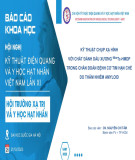
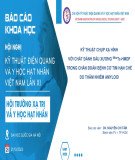

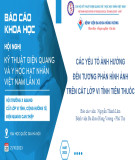
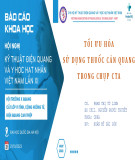
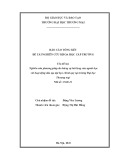
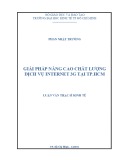
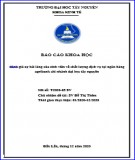
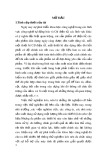

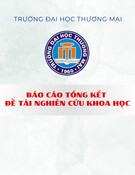




![Báo cáo seminar chuyên ngành Công nghệ hóa học và thực phẩm [Mới nhất]](https://cdn.tailieu.vn/images/document/thumbnail/2025/20250711/hienkelvinzoi@gmail.com/135x160/47051752458701.jpg)









